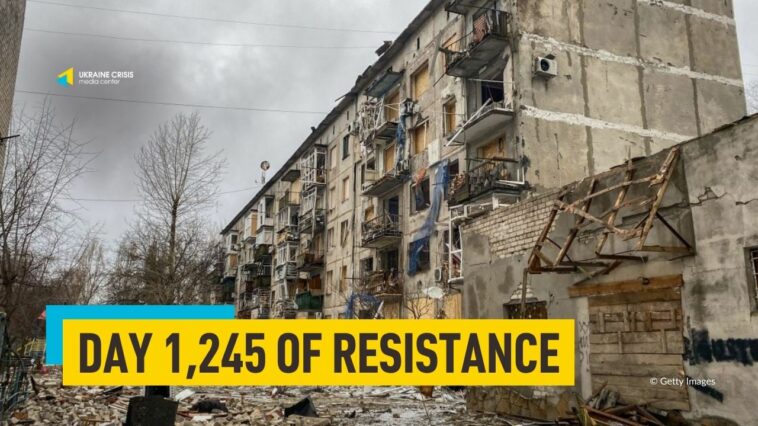Russian forces enter Pokrovsk in small groups. Ukrainian drones attack a Russian manufacturer of materials for explosives. Ukraine is already using the domestically-made Sapsan ballistic missile, analysts say.
Russian forces enter Pokrovsk in small groups
Ukrainian military personnel have confirmed to the country’s Ukrainska Pravda outlet that Russian forces have penetrated into the city of Pokrovsk in Donetsk region, the new site said on Tuesday.
According to their reports, the first groups of Russian infantry were spotted in Pokrovsk five days ago, on July 17.
DeepState, a Ukrainian OSINT project, said on Monday evening that an operation was underway to take out Russia’s sabotage groups.
“A few days ago the adversary penetrated into the city through the village of Zvirove, exploiting the fact that one of the brigades ran out of infantry personnel and that there was untrue reporting from the field. The 155th Separate Mechanized Brigade and the 68th Separate Jaeger Brigade had to urgently correct the situation so that it doesn’t grow into a catastrophe,” DeepState said.
Russian forces aim to consolidate the positions, get reinforcement and gain control of the Zakhysnykiv Ukrayiny [Defenders of Ukraine] street, it added.
As of Monday evening, Ukrainian troops continued to search for and take out Russian subversive groups inside the city.
“Unfortunately, we have also taken losses. Also, the number of friendly fire incidents rose as everyone knew about ‘subversive groups’ almost immediately, but most were unaware about their routes or whereabouts. That’s why the news on such incursions needs to be released with a cool head,” DeepState said.
A video of Ukrainian troops being ambushed at the intersection of the Shevchenka and Zakhysnykiv Ukrayiny streets has been already posted to social media, it added.
Commander-in-Chief of the Armed Forces of Ukraine, General Oleksandr Syrskyi said on Monday that a Russian subversive group was exposed and destroyed as it tried to enter Pokrovsk.
Ukraine drones attack Russian manufacturer of materials for explosives
Ukrainian drones attacked the Novokuybyshevsk petrochemical plant in Russia’s Samara region overnight into Tuesday. The site is one of Russia’s largest gas processing and petrochemical facilities, and is part of the military industrial complex, Head of the Center for Countering Disinformation at Ukraine’s National Security and Defense Council, Lieutenant Andriy Kovalenko said.
The operation was carried out by Ukraine’s Unmanned Systems Forces.
Kovalenko said the company manufactures materials that go into explosives, including benzene, phenol, acetone, alpha-Methylstyrene, synthetic ethanol and para-tert-Butylphenol. “The materials are used in the production of TNT, hexogen, tetryl, and other types of explosive substances. They are also used to equip artillery shells, aerial bombs, cluster munitions and missiles,” he explained.
According to media reports, the plant is the only Russian producer of synthetic ethanol and para-tert-Butylphenol.
The facility processes around one million tons of materials annually.
There were no details of the results caused by the strike.
Ukraine already using domestically-made Sapsan ballistic missile, analysts say
The Sapsan or “peregrine falcon” is Ukraine’s only domestically developed ballistic missile that the country has produced since 1991. It may well become a source of national pride and retaliation weapon, says Olena Zvarych in a column for Ukrainian media outlet Novynarnya. The following is an abridged version of the article that we translated into English.
A combat test of the missile in May 2025, likely a strike into Russia, was deemed successful by the Ukrainian military.
The Sapsan has a range of 500km with some experts saying some modifications would be able to strike targets up to 1,000km away. This means a Ukrainian ballistic missile will be able to come within range of Moscow if Ukraine scales up the production quickly.
Ukraine needs at least 1,000 ballistic missiles to mirror Russia’s attacks on the rear cities, Valentyn Badrak, Director of the Center for Army, Conversion and Disarmament Studies said. Ideally, Ukraine needs to stock around 5,000 such missiles.
Ukraine has started mass production of a short-range ballistic missile, the Sapsan or “peregrine falcon,” which was used for the first time in combat last month, striking a Russian military target about 300km away, head of the Office of the Ukrainian President, Andriy Yermak told The Times on June 23. There is a possibility that by praising the development the Ukrainian leadership is trying to offer European allies a financial or technical role in the country’s missile program.
Unnamed sources with knowledge of the matter said the Sapsan was successfully tested at a training ground in July 2024.
The Sapsan missile, packed with 480kg of explosives, has more than double the payload of a U.S. Army Tactical Missile System (Atacms) and can travel at more than five times the speed of sound, according to The Times.
Russia’s Iskander-M ballistic missile in its terminal phase of flight could exceed six times the speed of sound.
Ballistic missiles offer more outstanding penetration capability than cruise missiles. Ballistic missiles follow a parabolic trajectory toward their target and are more difficult to intercept.
The Sapsan is designed as a ground-to-ground missile system. Ukraine unveiled one of its parts — a tow vehicle at the Independence Day parade in 2018 and 2021.
Ukraine can modify the Sapsan into a sea- and air-launched system, said Mykhailo Honchar, President of the Centre for Global Studies “Strategy XXI”.
He cites an example of Russia’s Kinzhal air-launched ballistic missile that was modified from the Iskander.
Ukraine has upgraded the Neptune anti-ship cruise missile into the Long Neptune, a missile capable of striking ground targets up to 1,000km away, he added.




